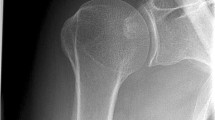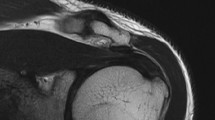Abstract
Acromial spurs reportedly relate to the impingement syndrome and rotator cuff tears. We classified the morphologic characteristics of the acromion (shape and thickness) and acromial spurs and determined whether they correlated with rotator cuff tears. We measured acromial shape and thickness using simple radiography and MR arthrography or CT arthrography in 106 patients with full-thickness rotator cuff tears and in 102 patients without tears. Acromial spurs could be classified morphologically into six types: heel, lateral/anterior traction, lateral/anterior bird beak, and medial. We found acromial spurs in 142 of the 208 patients (68%), and their incidence increased with age. The acromial spur was more common in the cuff tear group. The heel type was most common and detected in 59 patients (56%) in the cuff tear group and in 36 patients (35%) in the control group. The flat acromion was more common (60%) than curved and hooked acromion; however, there was no major difference between acromial shape and cuff tear. The mean acromial thickness was 8.0 mm, and the cuff tear group had thicker acromion. These data suggest acromial spurs can be classified according to the distinct morphology, and the most common heel-type spur might be a risk factor for full-thickness rotator cuff tears.
Level of Evidence: Level IV, diagnostic study. See Guidelines for Authors for a complete description of levels of evidence.








Similar content being viewed by others
References
Anderson K, Bowen MK. Spur reformation after arthroscopic acromioplasty. Arthroscopy. 1999;15:788–791.
Bigliani LU, Morrison DS, April EW. The morphology of the acromion and its relationship to rotator cuff tears. Orthop Trans. 1986;10:228.
Bigliani LU, Ticker JB, Flatow EL, Soslowsky LJ, Mow VC. [Relationship of acromial architecture and diseases of the rotator cuff] [in German]. Orthopade. 1991;20:302–309.
Bonsell S, Pearsall AW 4th, Heitman RJ, Helms CA, Major NM, Speer KP. The relationship of age, gender, and degenerative changes observed on radiographs of the shoulder in asymptomatic individuals. J Bone Joint Surg Br. 2000;82:1135–1139.
Chambler AF, Pitsillides AA, Emery RJ. Acromial spur formation in patients with rotator cuff tears. J Shoulder Elbow Surg. 2003;12:314–321.
Chansky HA, Iannotti JP. The vascularity of the rotator cuff. Clin Sports Med. 1991;10:807–822.
Edelson JG, Taitz C. Anatomy of the coraco-acromial arch: relation to degeneration of the acromion. J Bone Joint Surg Br. 1992;74:589–594.
Epstein RE, Schweitzer ME, Frieman BG, Fenlin JM, Mitchell DG. Hooked acromion: prevalence on MR images of painful shoulders. Radiology. 1993;187:479–481.
Fealy S, April EW, Khazzam M, Armengol-Barallat J, Bigliani LU. The coracoacromial ligament: morphology and study of acromial enthesopathy. J Shoulder Elbow Surg. 2005;14:542–548.
Harryman DT 2nd, Sidles JA, Clark JM, McQuade KJ, Gibb TD, Matsen FA 3rd. Translation of the humeral head on the glenoid with passive glenohumeral motion. J Bone Joint Surg Am. 1990;72:1334–1343.
Hayes PR, Flatow EL. Attrition sign in impingement syndrome. Arthroscopy. 2002;18:E44.
Hirano M, Ide J, Takagi K. Acromial shapes and extension of rotator cuff tears: magnetic resonance imaging evaluation. J Shoulder Elbow Surg. 2002;11:576–578.
Jim YF, Chang CY, Wu JJ, Chang T. Shoulder impingement syndrome: impingement view and arthrography study based on 100 cases. Skeletal Radiol. 1992;21:449–451.
Liotard JP, Cochard P, Walch G. Critical analysis of the supraspinatus outlet view: rationale for a standard scapular Y-view. J Shoulder Elbow Surg. 1998;7:134–139.
Neer CS 2nd. Anterior acromioplasty for the chronic impingement syndrome in the shoulder: a preliminary report. J Bone Joint Surg Am. 1972;54:41–50.
Neer CS 2nd. Impingement lesions. Clin Orthop Relat Res. 1983;173:70–77.
Nicholson GP, Goodman DA, Flatow EL, Bigliani LU. The acromion: morphologic condition and age-related changes. A study of 420 scapulas. J Shoulder Elbow Surg. 1996;5:1–11.
Nixon JE, DiStefano V. Ruptures of the rotator cuff. Orthop Clin North Am. 1975;6:423–447.
Nyffeler RW, Werner CM, Sukthankar A, Schmid MR, Gerber C. Association of a large lateral extension of the acromion with rotator cuff tears. J Bone Joint Surg Am. 2006;88:800–805.
Ogata S, Uhthoff HK. Acromial enthesopathy and rotator cuff tear: a radiologic and histologic postmortem investigation of the coracoacromial arch. Clin Orthop Relat Res. 1990;254:39–48.
Ogawa K, Yoshida A, Inokuchi W, Naniwa T. Acromial spur: relationship to aging and morphologic changes in the rotator cuff. J Shoulder Elbow Surg. 2005;14:591–598.
Ouellette H, Labis J, Bredella M, Palmer WE, Sheah K, Torriani M. Spectrum of shoulder injuries in the baseball pitcher. Skeletal Radiol. 2008;37:491–498.
Ozaki J, Fujimoto S, Nakagawa Y, Masuhara K, Tamai S. Tears of the rotator cuff of the shoulder associated with pathological changes in the acromion: a study in cadavera. J Bone Joint Surg Am. 1988;70:1224–1230.
Panni AS, Milano G, Lucania L, Fabbriciani C, Logroscino CA. Histological analysis of the coracoacromial arch: correlation between age-related changes and rotator cuff tears. Arthroscopy. 1996;12:531–540.
Toivonen DA, Tuite MJ, Orwin JF. Acromial structure and tears of the rotator cuff. J Shoulder Elbow Surg. 1995;4:376–383.
Tucker TJ, Snyder SJ. The keeled acromion: an aggressive acromial variant—a series of 20 patients with associated rotator cuff tears. Arthroscopy. 2004;20:744–753.
Acknowledgments
We thank Ki Hyun Jo, MD, Suk Jae Lee, MD, Hye Ran Kim, and Sang Mi Shim for support with data collection and patient recruitment. We also thank Pacific Edit for reviewing English in the manuscript before submission. Statistical analyses were performed by Hyun Kang, PhD, from the statistics department of our institution.
Author information
Authors and Affiliations
Corresponding author
Additional information
Each author certifies that he or she has no commercial associations (eg, consultancies, stock ownership, equity interest, patent/licensing arrangements, etc) that might pose a conflict of interest in connection with the submitted article.
Each author certifies that his or her institution has approved the human protocol for this investigation and that all investigations were conducted in conformity with ethical principles of research.
This work was performed at Seoul National University College of Medicine, Seoul, Korea.
About this article
Cite this article
Oh, J.H., Kim, J.Y., Lee, H.K. et al. Classification and Clinical Significance of Acromial Spur in Rotator Cuff Tear: Heel-type Spur and Rotator Cuff Tear. Clin Orthop Relat Res 468, 1542–1550 (2010). https://doi.org/10.1007/s11999-009-1058-5
Received:
Accepted:
Published:
Issue Date:
DOI: https://doi.org/10.1007/s11999-009-1058-5




